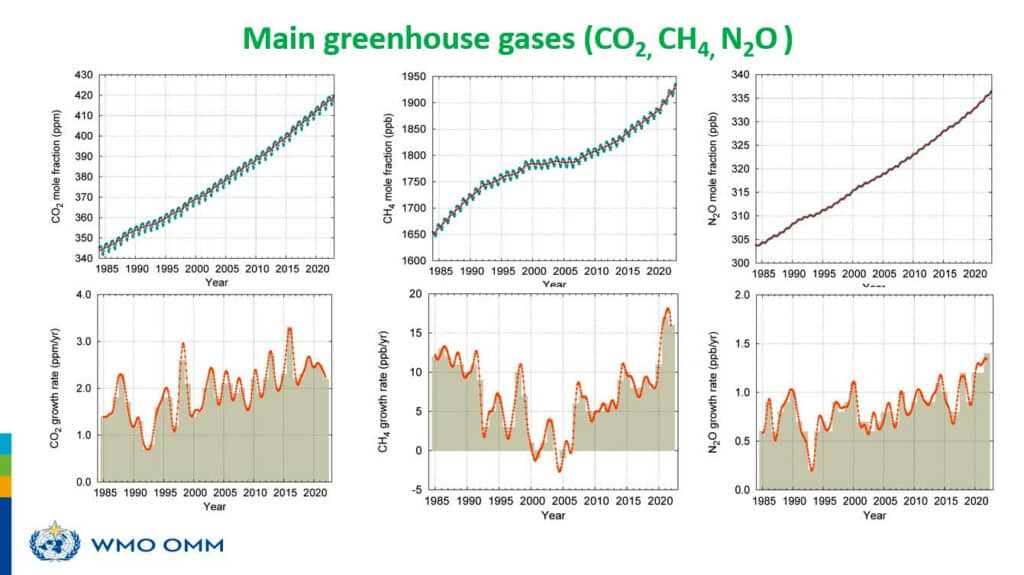The abundance of heat-trapping greenhouse gases in the atmosphere once again reached a new record last year and there is no end in sight to the rising trend, according to a new report from the World Meteorological Organization (WMO).
Global averaged concentrations of carbon dioxide (CO2), the most important greenhouse gas, in 2022 were a full 50% above the pre-industrial era for the first time. They continued to grow in 2023.

Methane concentrations also grew, and levels of nitrous oxide, the third main gas, saw the highest year-on-year increase on record from 2021 to 2022, according to the Greenhouse Gas Bulletin, which is published to inform the United Nations Climate Change negotiations, or COP28, in Dubai.
“Despite decades of warnings from the scientific community, thousands of pages of reports and dozens of climate conferences, we are still heading in the wrong direction,” said WMO Secretary-General Prof. Petteri Taalas.
“The current level of greenhouse gas concentrations puts us on the pathway of an increase in temperatures well above the Paris Agreement targets by the end of this century. This will be accompanied by more extreme weather, including intense heat and rainfall, ice melt, sea-level rise and ocean heat and acidification. The socioeconomic and environmental costs will soar.. We must reduce the consumption of fossil fuels as a matter of urgency.,” said Prof. Taalas.
Just under half of CO2 emissions remain in the atmosphere. Just over one quarter are absorbed by the ocean and just under 30% by land ecosystems like forests – although there is considerable year-to-year variability in this. As long as emissions continue, CO2 will continue accumulating in the atmosphere leading to global temperature rise. Given the long life of CO2, the temperature level already observed will persist for several decades even if emissions are rapidly reduced to net zero.
The last time the Earth experienced a comparable concentration of CO2 was 3-5 million years ago, when the temperature was 2-3°C warmer and sea level was 10-20 meters higher than now.
The Annual Greenhouse Gas Index, published by the US National Oceanic and Atmospheric Administration, shows that from 1990 to 2022, the warming effect on our climate – called radiative forcing – by long-lived greenhouse gases, increased by 49%, with CO2 accounting for about 78% of this increase.
Carbon dioxide is the single most important greenhouse gas in the atmosphere, accounting for approximately 64% of the warming effect on the climate, mainly because of fossil fuel combustion and cement production.
The 2.2 parts per million (ppm) increase in the annual average from 2021 to 2022 was slightly smaller than 2020 to 2021 and for the past decade (2.46 ppm yr). The most likely reason is increased absorption of atmospheric CO2 by terrestrial ecosystems and the ocean after several years with a La Niña event. The development of an El Niño event in 2023 may therefore have consequences for greenhouse gas concentrations.
Methane is a powerful greenhouse gas which remains in the atmosphere for about a decade, accounting for about 19% of the warming effect of long-lived greenhouse gases. Approximately 40% of methane is emitted into the atmosphere by natural sources (for example, wetlands and termites), and about 60% comes from anthropogenic sources (for example, ruminants, rice agriculture, fossil fuel exploitation, landfills and biomass burning).
The increase from 2021 to 2022 was slightly lower than the record rate observed from 2020 to 2021 but considerably higher than the average annual growth rate over the last decade.
Nitrous Oxide is both a powerful greenhouse gas and ozone depleting chemical. It accounts for about 7% of the radiative forcing by long-lived greenhouse gases.
N2O is emitted into the atmosphere from both natural sources (approximately 60%) and anthropogenic sources (approximately 40%), including oceans, soils, biomass burning, fertilizer use, and various industrial processes. For N2O, the increase from 2021 to 2022 was higher than that observed any time before in our modern time record.




